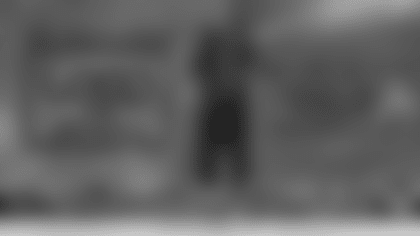Opening State-of-the-Art Lucas Oil Stadium a Special Moment, Dungy Says
INDIANAPOLIS – Tony Dungy has been in this situation before.
And if Dungy, entering his seventh season as the Colts' head coach, remembers anything about the last time he coached a team opening a new stadium, it's this:
A stadium in the NFL is more than a stadium.
And it's more than just a place where an NFL team plays home games.
In the case of Lucas Oil Stadium – the new stadium that will host an NFL game for the first time when the Colts play host to the Buffalo Bills in a game broadcast nationally on the NFL Network on Sunday, August 24 at 8 p.m. – Dungy said that is particularly true.
It's state-of-the-art. It's very, very, big.
It's a civic centerpiece, a point of pride not only for the team and its fans, but for the Indianapolis and Indiana communities.
Its opening season, Dungy said, will be a unique time.
A time to celebrate. A time to remember.
And a time to savor.
"It will be special," Dungy said recently. "I've done it one other time, down in Tampa (in 1998). It's unique. Your players take a lot of pride in the fact that the city and the state and everybody got behind it to get us a new place. Anytime you have a new home, it means something.
"We have a lot of guys who played a ton of games in the RCA Dome, so it will be even more special for those guys, I think."
Lucas Oil Stadium is a retractable roof facility located across the street in downtown Indianapolis from the RCA Dome, the Colts' home since 1984. The facility, under construction since the fall of 2005, has a FieldTurf field, and will hold 63,000 fans for football games – expandable to 70,000 – and approximately 45,000 for basketball.
"We're big-time now," Colts defensive end Robert Mathis said. "It's a sight to see."
Lucas Oil Stadium is scheduled to hold not only the 2012 Super Bowl, but the 2010 NCAA Men's Final Four and the 2011 NCAA Women's Final Four, as well as numerous other events including conventions and musical concerts.
"I think it's very exciting in the sense of what it means going into the 21st Century, not just for the Colts, but for our city, for our state, for the NCAA and for the events that will be there – for the whole convention center and the development for downtown," Colts Owner and Chief Executive Officer Jim Irsay said. "It's great to be part of something. You can go back to 1992, 1995, 1997 and if someone had told you, 'This is what the future's going to look like,' everyone would be pretty blown away by those things. You don't take it for granted.
"At the same time, when I see something like that, you take some time to take it in and appreciate it. Certainly, it's a great tribute to everyone involved that has been part of it. I believe in dreaming big and I believe in things that inspire. I know when it's working how special it is when you're growing together.
"That's imant to me, because it's about inspiration and people looking at that and taking pride in our state and our city and knowing this is the finest facility in the world. It's special and historic. This is what it's about in terms of going into the next century."
Irsay's far from the only person anticipating the first season in the stadium.
As construction drew near a close in recent months and Lucas Oil Stadium began dominating the city's skyline, some players toured the facility, while others had a more distant view.
"Driving down the highway, you can see it and the dome just looks tiny next to it," Colts offensive tackle Ryan Diem said. "It's a state-of-the-art facility and besides football, they're going to have some other exciting events there, so it will be cool. It's exciting for the town."
And while the stadium has drawn national and local attention as the home of the Colts, and the site of the 2012 Super Bowl, Colts President Bill Polian said the venue has a deeper, more important story.
"I think it's a big deal for the organization, clearly," Polian said. "The symbolism of having it be the 25th anniversary (of the Colts in Indianapolis) – there's a real significance to that. I think what's become lost is the value of the building to the city. Yes, it's valuable to us, clearly. Yes, it makes us viable for the long-term. Yes, we will have a Super Bowl and that's tremendous for Indianapolis.
"But we're also going to have Drum Corps International. We're going to have five (NCAA Men's) Final Fours. We're going to have (NCAA) Women's Final Fours. We're going to have NCAA Conventions. We now can host a national political convention if that were the case. We're going to bring back conventions in the new convention space that have left Indianapolis and we'll attract many more.
"In the long-term, the building itself and its usefulness to the overarching economic health of Indianapolis has sort of been lost in all the excitement about the Super Bowl and the Colts. To me, (former Indianapolis) Mayor Bart Peterson's vision of seeing how that fit in the larger scheme of things and crafting it that way is really a huge, huge plus for the city and for the state."
The stadium is a massive seven-level structure that will feature not only a mechanized retractable roof, but a moveable "window wall," each of which will allow for quick conversion and allow Colts games to be played indoors or outdoors.
The retractable roof divides lengthwise, with each half sliding down the stadium's sloping roof. The roof is gabled, with the peak running north and south down the center of the field. The roof panels move to the open position at the touch of a button in nine minutes.
One of the stadium's most unique features is the window wall – a windowed area at one end of the stadium that will allow additional light when closed and an open feel when opened. The wall is 214x88 feet, and made up of six 88x38 feet glass panels.
The wall separates at the center, with three panels on each side when open. It opens and closes in six minutes.
"The size is very impressive," Colts Senior Executive Vice President Pete Ward said. "There will be a big, 'Wow,' factor in this building.'''
Compared to the RCA Dome, the Colts' former home stadium, the new facility features wide seats, more leg room, more points of sale, more restroom facilities and wider concourses, Ward said this past offseason.
"There's nothing like it in the country," Lucas Oil Founder Forrest Lucas said. "It's going to be totally different. You're going to be able to go in and be entertained for hours before the game. That's the idea of it."
A key component of the new stadium, Ward said, is its conduciveness to partnerships. Areas throughout the stadium such as food courts, wide concourses, plazas and multiple levels can be sponsored, a necessary attribute to a modern sports stadium.
"That was a goal of ours and something we worked with the architects on," Ward said, because "in terms of local revenue, (a stadium) either makes it or breaks it for you."
The importance of sponsorships and partnerships in the design and planning stages of the new stadium can't be underestimated, Ward















